The HTC 10 Review
by Joshua Ho on September 19, 2016 8:00 AM ESTSystem Performance Cont'd
Now that we've discussed how the HTC 10 performs in general purpose task we can turn our attention to tests that attempt to better test how a device performs in 3D gaming and other tasks that more strongly emphasize GPU and 3D API performance.

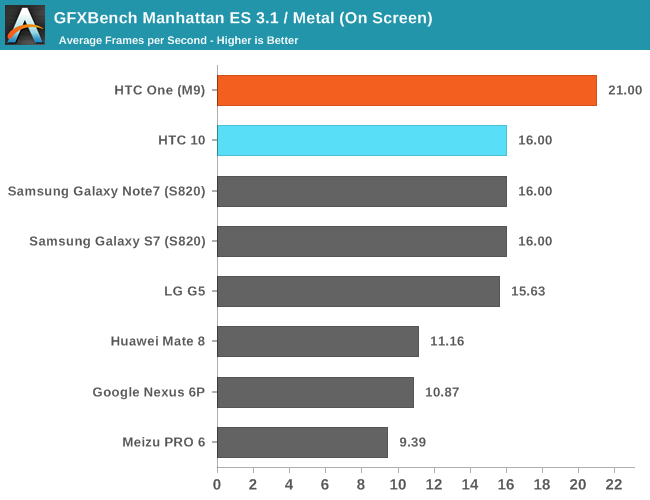


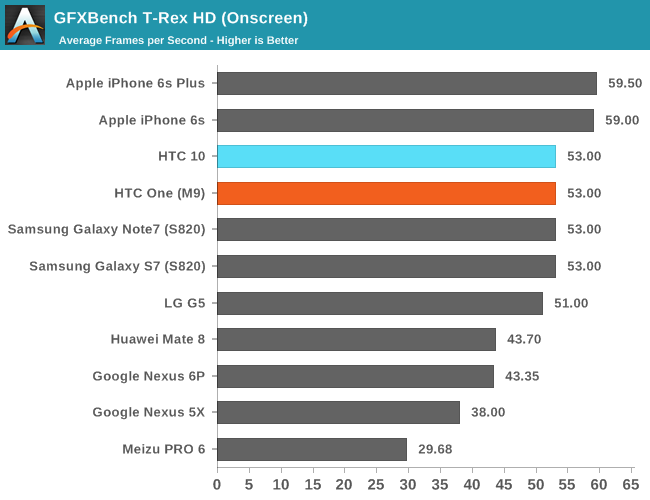
In the on-screen tests we can see the impact that the extra resolution has on GPU performance. Despite Adreno 530 providing a significant performance uplift the HTC 10 can actually give less GPU performance at native resolution depending upon the workload. Car Chase is fairly tesselation-intensive and uses ES 3.1, while ES 2 and ES 3 tests like Manhattan and T-Rex see parity between the two.
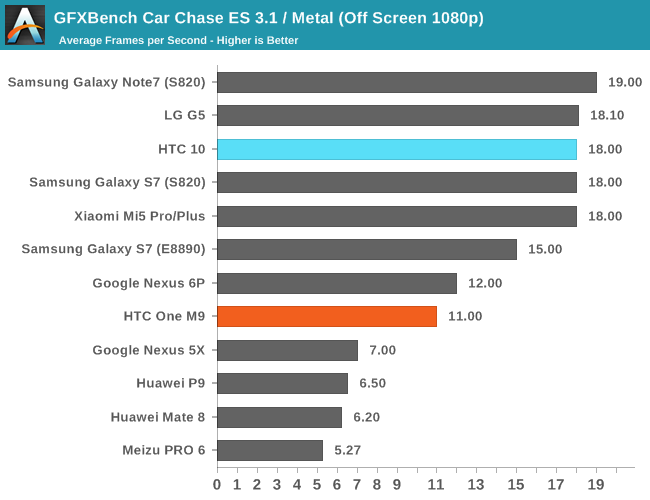
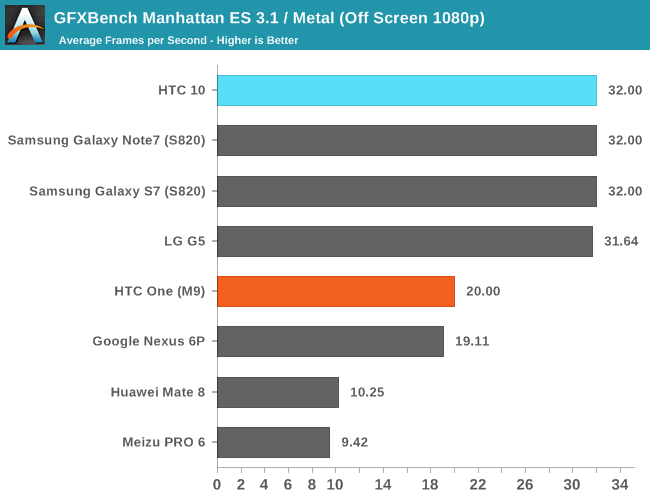
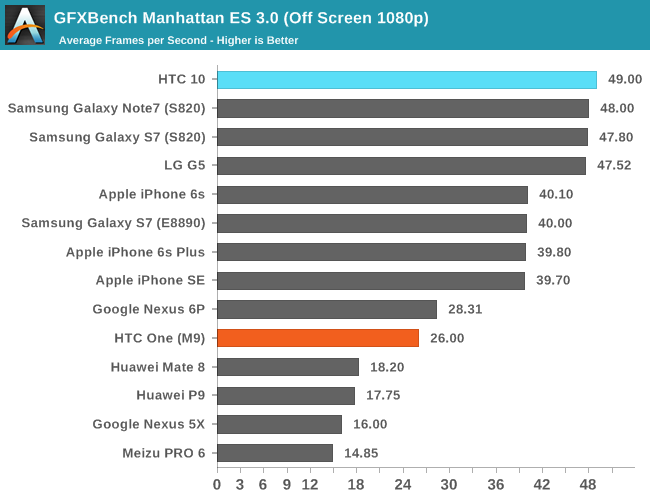
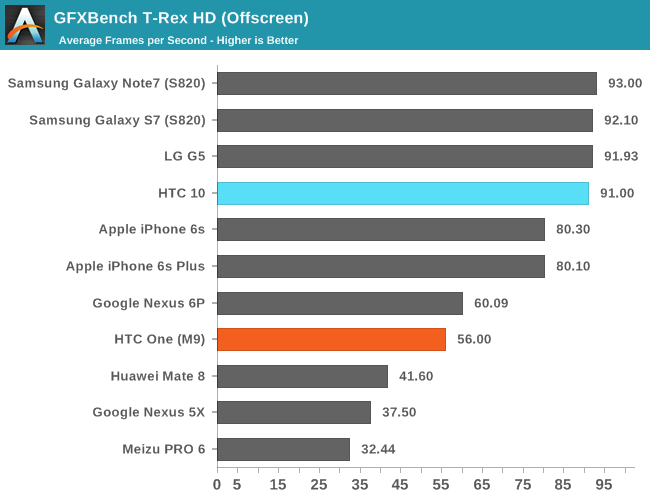
In 1080p off-screen rendering we see performance similar to applications that would render at non-native resolutions. Here the HTC 10 significantly outperforms the One M9 across the board and is in line with other Snapdragon 820 devices which is probably not a surprise.
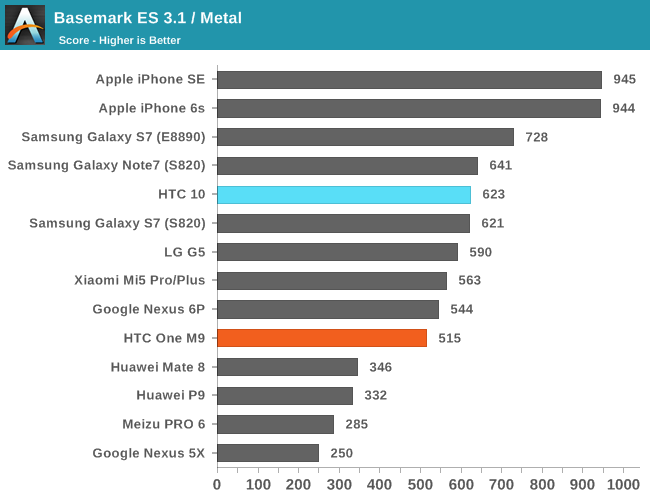
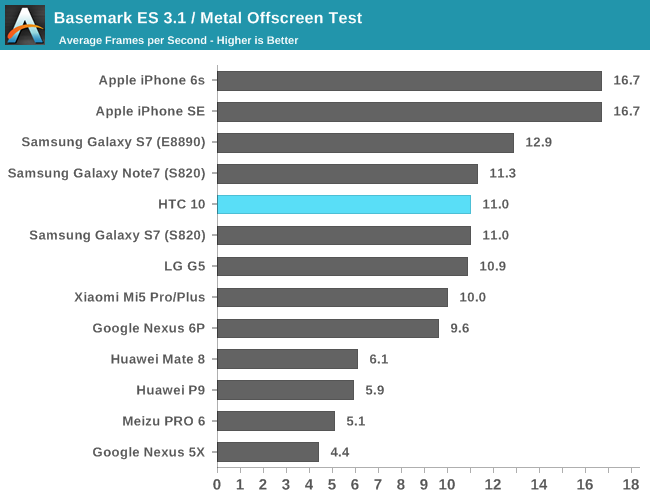
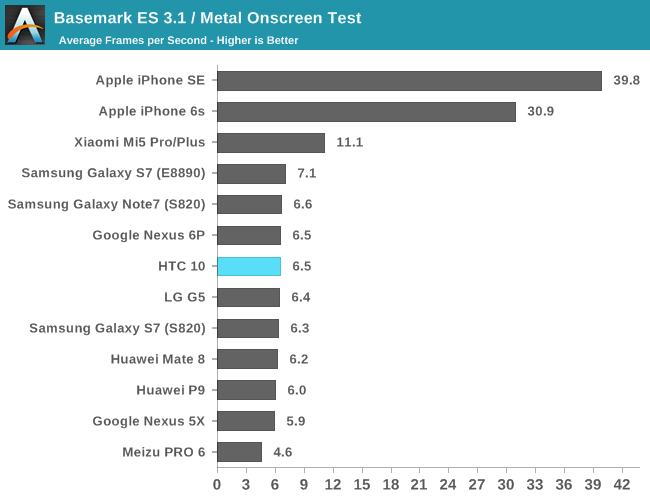
Performance here shows an uplift over the One M9, but this is primarily because the scores are based upon the off-screen results where resolution is equalized.
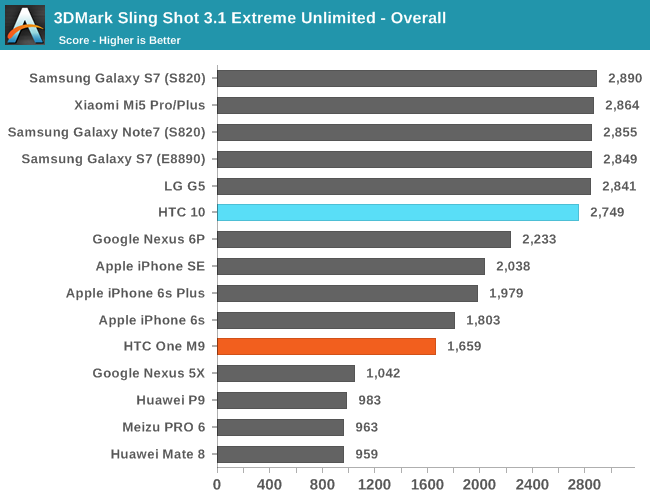
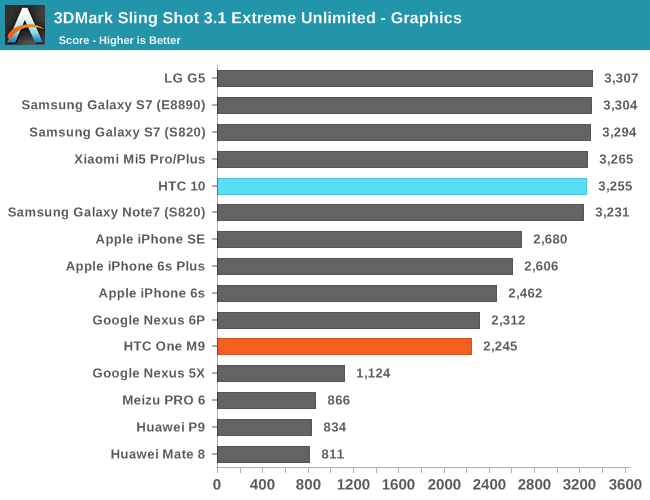
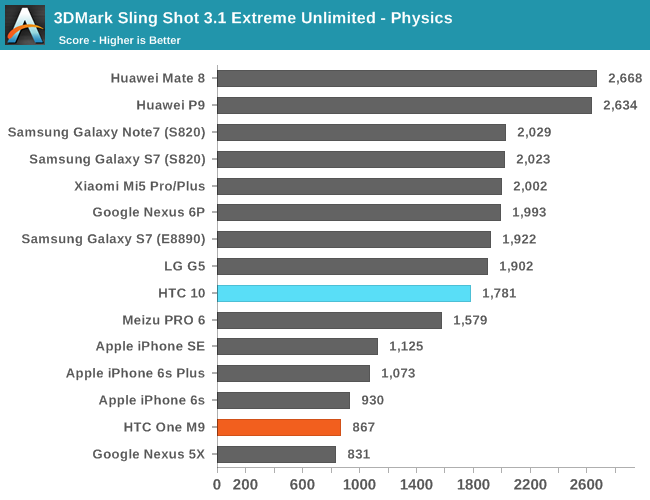
As 3DMark relies on off-screen rendering again we can see the benefit of Adreno 530 over Adreno 430 but this can only be achieved if you use the game optimization settings in the Boost+ application. Overall this isn't particularly notable outside of simple verification that nothing is seriously wrong with the software and hardware on the HTC 10.
NAND Performance
Storage performance, while decidedly difficult to test well in the mobile space and generally not all that well covered remains a fairly critical component of overall system performance. It’s definitely possible to hide memory performance issues with caching, but if you’ve ever taken a course on these things you can see that there is an upper bound to performance when it comes to caching. As a result, being able to improve performance at each step of the memory mountain is critical to having low latency and high throughput for data in the system. In order to test storage performance on mobile devices, we continue to rely on AndroBench 4 for Android devices. In order to properly test storage performance in a somewhat realistic manner we elect to test with only one I/O thread and a 100 MB test set with 4KB and 256KB block sizes for random and sequential rather than the strange settings of 8 threads and a 32MB sequential test which seems to be geared towards generating the largest numbers humanly possible rather than any meaningful throughput figure.
In the case of the HTC 10 it’s probably not a surprise at this point but it uses iNAND 7232 from SanDisk, seemingly as a single source supplier. This uses the SLC/TLC hybrid configuration seen in devices like the LG V10, iPhone 6, 6s, and 7 as well. The SLC storage is on the order of a few hundred megabytes, so sequential writes that exceed this size will see a drop-off in performance.
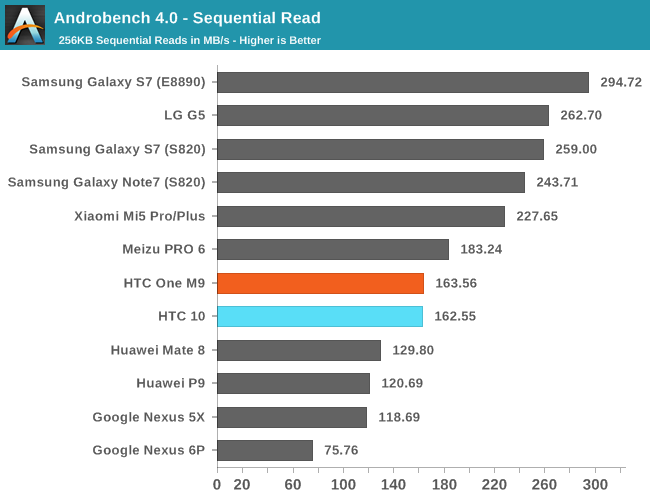
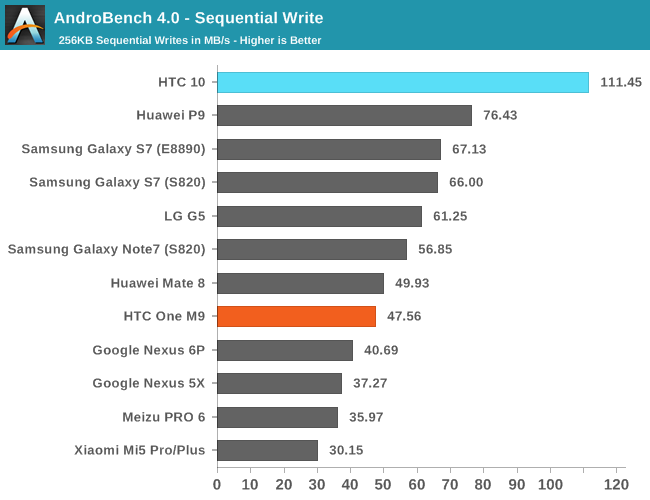
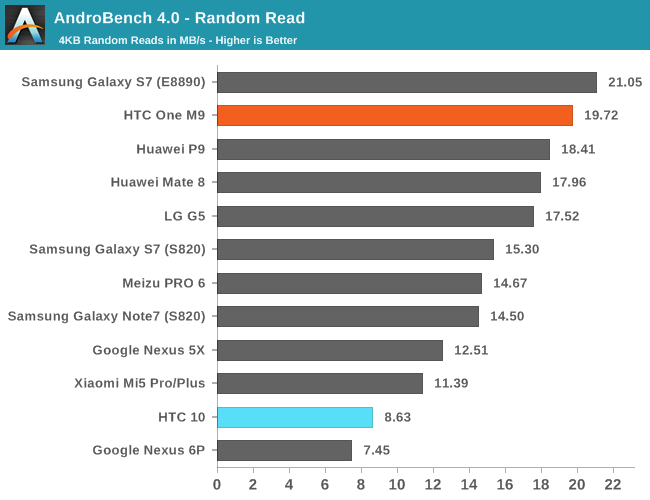
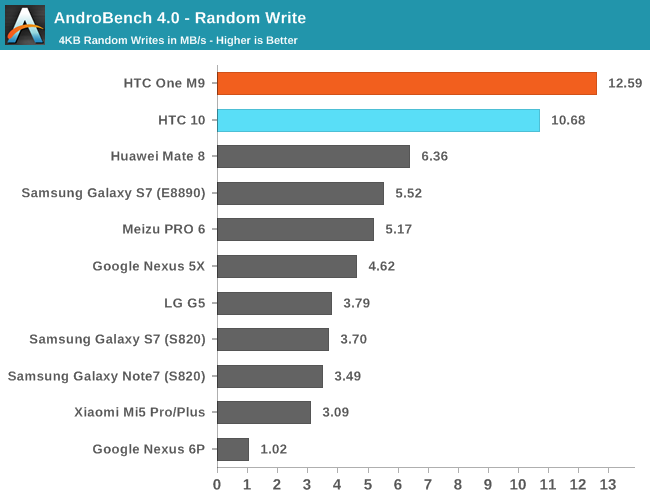
These results are probably not a surprise if you’ve been following our recent coverage but it’s still worth noting how the use of eMMC 5.1 is not guaranteed to be a huge impediment, although I would say this is probably the last generation where it’s acceptable to ship eMMC in a flagship device as the eMMC spec doesn’t seem to be progressing much further and UFS/NVMe solutions really seem to be the way forward as far as the industry is concerned. The HTC 10 is not really that far off from the UFS solutions we’ve seen in phones like the Galaxy S7 and from the Discomark results you can see that the eMMC 5.1 solution used here isn’t really causing a huge difference in performance, but I suspect anything that can actually take advantage of UFS’ more sophisticated controller will really start to highlight the weakness of eMMC and SDIO. At this point the industry already has UFS as a fairly widespread standard so HTC could take this route for a future flagship or NVMe storage depending upon their logistics. It's really important to emphasize here how UFS and NVMe are not necessarily better one way or another, as these things only matter when the storage or storage controller isn't the bottleneck.










183 Comments
View All Comments
Badelhas - Tuesday, September 20, 2016 - link
My experience with HTC has been great, including the HTC Vive. Do you have any HTC product to support your theory?JeffFlanagan - Tuesday, September 20, 2016 - link
If you've dealt with Vive support, you already know what I'm talking about. It's no secret that their support is hopeless.ACM.1899 - Monday, September 19, 2016 - link
tnx for the review . great Job. impressed with the Camera. how about audio quality? although we know it's great. so there is no DAC? i've heard (read) there is.in android phones , i guess HTC 10 is the best as long as you don't like One+3 or a Nexus (Pixel).
specially Nexus devices that somehow are at the beginning of their era , compared to HTC's that i think are at the end.
Haldi - Monday, September 19, 2016 - link
Qualcomm AqsticACM.1899 - Monday, September 19, 2016 - link
and by end i meant : not much left to achieve... ;)zepi - Monday, September 19, 2016 - link
Nice review.What should I make of the that HTC wifi performance figure? Your graph shows that it still has some throughput at well under -80dBm signals when other phones stop much earlier?
Then in the test you mention signal strengths are about 5dB worse than with S7. Should I read this that in the end, all phones lose connectivity at roughly same location?
WoodyPWX - Monday, September 19, 2016 - link
Where are the OnePlus 3 in the results for a comparison? That phone actually kills HTC 10. Is that a coincidence?Lau_Tech - Monday, September 19, 2016 - link
Hi Josh, thank you. I enjoyed this review greatly and learnt much from it. I bought the HTC 10 in May and through my own informal testing I can confirm the majority of your findings regarding the build quality, camera, WIFI performance, U.I and even display contrast (however, my screen does not have the "pink" off angle issue though, possibly because it is a Sharp-manufactured panel).One area which the HTC 10 is a stand-out (and possibly still worth due consideration even at this juncture) is in its internal audio performance. I understand that Anandtech lacks the equipment to test this objectively but I can confirm that the HTC 10 is within a select group of smartphones that audiophiles can consider. (the others being the LG V10,V20, Iphone 6s,7 and possibly the ZTE axion 7.)
From your review I infer that this has become your new daily driver. Coming from a One Plus One, I do agree the rock-solid reliability of the Sense U.I is a big differentiator. The HTC 10 really is a phone that ages well, and the software updates do quite alot to address the obvious issues that crop up. in version 1.90 the option for 16second shutter delay was also added, I wonder what are your thoughts on this? For me it seems largely unusable without a tripod.
Once again, thanks for getting this out, and for taking the 'badgering' in your stride. Having read and watched every review of the HTC 10 on the web I can say without qualification that this one is by far the best. Well done!
Lau_Tech - Monday, September 19, 2016 - link
https://www.ptt.cc/bbs/MobileComm/M.1462332737.A.C...A taiwanese side-by-side of the two panels. I must say the Sharp Panel does seem more subjectively appealing.
ACM.1899 - Monday, September 19, 2016 - link
couldn't agree more